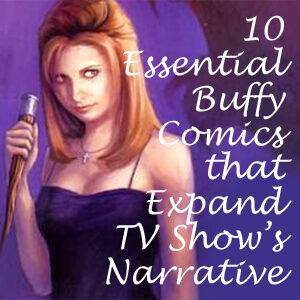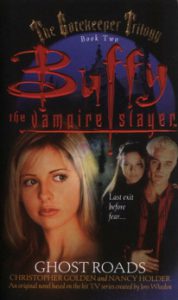In my review of “Out of the Madhouse,” I noted that it can only take place between “Revelations” and “Lovers Walk,” and that we just have to accept that Faith is for some reason not in the story. But a lot of fans view the “Buffy” novels as a parallel timeline, and with “The Gatekeeper Trilogy Book 2: Ghost Roads” (March 1999), I can see the appeal of that approach.
As with Book 1, there are a handful of moments that make it clear Christopher Golden and Nancy Holder intend to have this take place in 1999, rather than late 1998, most notably on page 36: “The year was 1999 …” Springboarding from early Season 3 (but skipping Faith), the authors essentially take the Scooby Gang in their own direction.
Reading “Ghost Roads,” I feel like the authors were inspired by “Anne” (season 3, episode 1), which shows Buffy living on her own in L.A. I can imagine this drove them to show her fending for herself in battles around the globe, whereas the TV show took a step back and kept the action in Sunnydale. There’s a line on page 310 that makes me think the authors saw “Anne” just before the novel’s prose was locked down. When the villain Fulcanelli threatens Buffy with Hell, she notes that “It was a nice place to visit, but I wouldn’t want to live there.”
The books’ character arcs, though, run a close parallel to Joss Whedon’s Season 3. On page 76, Willow – talking about their respective parents’ expectations for their kids — tells Cordelia: “I’m my own Willow, and nobody knows what I want except me.” This has echoes of “Gingerbread” (3.11) – which aired slightly before this – where Willow memorably tells her mom, “I’m not an age group. I’m me. Willow group.”
The authors are sometimes anxious to move these characters’ arcs forward. It’s not until “Doppelgangland” (3.16) that Willow sends a pencil flying into a tree, yet she’s binding demons into their hell dimension here. Granted, we could see this as a similar situation to late Season 2, when Willow continues working on a spell started by Jenny Calendar; she gets some help from Giles and the Gatekeeper here. But she seems perhaps too adept at magick in “Ghost Roads.”
Although Golden and Holder have an excellent feel for these characters and their banter (which is not as heavy on quips as I remembered), they obviously regard Oz and Cordy as tighter members of the group than the TV show does. Cordy has a nice heart-to-heart with Willow in the aforementioned scene, and she touchingly invites Willow to go shopping with her after this crisis ends. The scene gains an extra layer of very “Buffy”-esque poignancy if one imagines this fits on the TV show timeline and therefore Willow and Xander had been kissing recently.
Oz, meanwhile, fights side-by-side with Angel and Buffy as they trek through England, France and Italy, with enough cultural details to me think one of the authors had recently taken a European vacation. Oz holds his own, a rather large leap in logic from what we had seen on TV, where he is competent at staking vampires but wouldn’t be categorized as a fierce warrior. It’s worth it for one awesome line, though. On page 314, Buffy asks the time, wondering if it’s safe for Angel to be outside yet. Oz says, “It’s dusk,” and turns into his werewolf form. Perhaps it’s a convenient way for the trio to get out of their jam, but it’s a fun one.

Joyce also gets a lot more action in the books. Although she acknowledges that she can’t be on the front lines with Buffy (ironically, she does try patrolling with her in “Gingerbread”), she is much more connected with the Scooby Gang’s world here. Indeed, the Sons of Entropy kidnap her, aiming to trade her for Buffy. Joyce is well-written: believably terrified, yet also stubborn enough to tell her captors at one point that Buffy is going to kill them.
Spike and Dru – who we learned on the final page of “Out of the Madhouse” are holding the Gatekeepers’ heir – get a lot more page-time in “Ghost Roads,” but it’s filler – albeit spot-on filler of the lovebirds bickering about whether Dru can eat the 11-year-old heir, Jacques Regnier.
The vampires have the heir, the Gatekeeper has the Spear of Longinus; the Sons of Entropy want the heir, so therefore they need to get the Spear from the Gatekeeper. The authors don’t give us the backstory of how this standoff came about. How did Spike and Dru know Jacques was worth nabbing? Did the Sons of Entropy put out the word? If so, wouldn’t it have made more sense to find Jacques themselves, since they can’t give Spike and Dru want they want in exchange? It seems like intrigue and action scenes of Spike and Dru discovering the SOE’s schemes, then grabbing Jacques, would be a better use of these characters.
At any rate, we end up with another awkward Buffy-Spike team-up, similar to the end of Season 2, except that Angel’s on their side too this time. It seems the authors are drawn to the Buffy-Spike chemistry, just like the showrunners.
Golden and Holder are also Amy fans, as they can’t resist giving Sunnydale’s resident teen witch a cameo, just as the TV show did about once per season (in “Gingerbread” in Season 3). The monster activity is so extreme in the town that even Amy is out and about, casting spells for the cause of good (something that again makes it clear that the authors did not know that Faith would be introduced when they wrote this trilogy).
Xander is in mortal peril by the end of “Ghost Roads,” leaving Willow and Cordelia with matching looks of horror on their faces. I’m not too worried about him – and probably wasn’t on the first read, either – but it’s another example of the bigness of Golden and Holder’s works. They aren’t content to write inconsequential little side yarns.
Click here for an index of all of John’s “Buffy” and “Angel” reviews.

